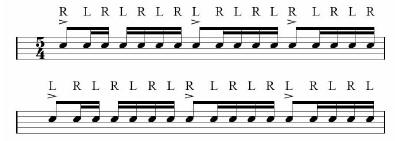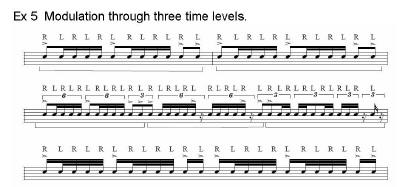|
| Fast Indian stickings
involving singles |
This lesson involves a sticking
approach which is really useful for executing very fast clusters
of sixteenths or thirty second notes using singles. The idea
came about when I recently had to execute some fast Indian style
rhythmic passages on Bongos. In the past I had articulated these
patterns with doubles combined with singles which seemed to work
fine on drums such as Darabouka and also with drums played with
sticks. Unfortunately, by using doubles on the bongos a lot of
the attack and aggression of the patterns was lost. The other
problem was that continually leading with the right made if very
hard to articulate these patterns at fast speed for long
periods. It lead me to the development of a set of phrases
involving singles which alternate between right lead and left
lead.
Take this phrase for example;
EX 1

It makes sense to play it as written, always leading with the
right. However, try playing it like this;
EX 2 - 4 1/8th note unit, forward and reverse.

I guarantee that with a small amount of practice you will be
able to get this a lot faster than example 1. In ex 1 the right
hand is continuous and never gets a break. In Ex 2 the work is
divided more evenly between the hands. The issue here is getting
the left hand as strong as the right. The importance of this
cannot be over emphasised.
Having embraced this concept lets get a few building blocks of
various lengths so we can develop some more interesting patterns
and phrases.
Ex 3 – 3 1/8th note unit, forward and reverse.

Ex 4 - 3 1/8th note unit, forward and reverse offset.

Ex 5 - 4 1/8th note unit, forward and reverse offset.

Ex 6 - 5/4 unit, forward and reverse.

Notice that with example six it is a much longer and more
interesting phrase. (Obviously this can be offset as in the
previous offset examples). This is where we want to get with
this concept with the objective of being able to improvise
freely in sixteenths and thirty seconds moving backwards and
forwards between right and left lead. It can lead to some
interesting accents on either hand which can be played on other
drums, cymbals etc. It is also for integration into the ‘left
hand lead’ style of playing used by players such as Simon
Phillips.
Now we will we will elaborate on some of these ‘reverse
phrasing’ patterns. Remember, this is a good way to articulate
fast sixteenth and thirty second note clusters and phrases
alternating right and left hand lead. The results can be similar
to some of the phrasing you hear in Indian percussion. Check out
some of the recent stuff by Steve Smith and Russ Miller, along
with the amazing music of Shakti with John Mclaughlin. Also,
there is a piece on Benny Grebb’s new DVD that we did together
where these type of phrases have been used.
Lets take some simple additions to create patterns in 4/4.
3 + 3 + 3 + 3 + 4 = 16
This simple mathematical approach is great to build rhythmic
patterns using simple building blocks. For example, if you were
working in 5/4 then you could have;
3 + 3 + 3 + 3 + 4 + 4 = 20
or;
3 + 3 + 4 + 4 + 3 + 3 = 20
The possible permutations are endless. It also makes working in
odd time signatures a lot easier. Lets look at our 4/4 equation
and use the rhythmic motifs from last months article. (I will
notate these in their individual components to make the concept
clearer. It means writing these first two examples in 8/4).
EX 1 (3 + 3 + 3 + 3 + 4 = 16)

Notice how this spans over two 4/4 bars because we end on the
right with the last stroke in the first bar and therefore begin
with the left in the second bar.
Now lets orchestrate some of these accents out on the toms.
Ex 2 (3 + 3 + 3 + 3 + 4 = 16 with accents on toms)

You can use these components in any order. They will always add
up to 4/4 (8/4)
3 3 4 3 3
3 3 3 4 3
3 4 3 3 3 Etc.
Now we will add a simple 2/8 unit to our core phrases which will
give us a little more choice in building patterns.
Ex 3 New core phrases in 2/8

Now using this and the 3/8 phrase we will create a simple new
4/4 pattern
Ex 4

Now we will modulate this through three time levels, sixteenths,
sixteenth triplets and thirty second notes. Depending on the
tempo, these patterns can sound great as sixteenths but they are
truly ripping as thirty second notes. Modulation through
triplets is also a great exercise. Bear in mind you are not
learning anything new technically here apart from how you ‘HEAR’
the phrase. Playing a quarter note foot ostinato through this
will help the understanding of this a lot. Do it with a
metronome. Start slowly and build up. It develops an
understanding of gear shifts often used by great players such as
Keith Carlock.
Ex 5 Modulation through three time levels.

I have indicated the phrase lengths under the notation to ease
understanding. It is not always immediately apparent how to find
a direct application for things like this. However, it continues
to develop and push your rhythmic skill sets and every min spent
in the practice room working on material like this puts you in a
stronger position technically to achieve the goals you aspire to
as a player. Keep working and searching but above all, keep
believing. Do not expect the results to be instant and be
patient.
Now we will conclude our look at the ‘reverse phrasing’ patterns
we have been developing. These stickings are good for any single
or multi toned percussion instruments, from snare drum to
Congas, drum set and tuned percussion. Below I am going to
notate each example on one line but I want you to go through all
the following steps with each one.
1. As written
2. Play all ‘R’ accents on floor tom and all ‘L’ accents on the
small tom
3. Add quarter note foot ostinato. (Also, work on other common
foot ostinatos as well, such as left foot clave etc)
4. Play four bars at sixteenth note level and then four bars of
thirty second note level. Do this with and without the foot
ostinato.
I will indicate the phrase lengths underneath each example.
Remember though, these are only the phrases we have already
looked at in the previous articles. However, sometimes these are
displaced and / or slightly altered. The concept however remains
the same.
Ex 1 (4 + 4 + 3 + 3 + 2)

Ex 2 (3 + 3 + 4 + 3 + 3)

Ex 3 (4 + 3 + 3 in 5/4)

Example 4 is slightly more elaborate. It takes the 5/4 bar in
example 3 and repeats it twice and then extends it further with
four repeats of the 3/8 phrase. This clearly shows the use of
the odd length phrases in creating interesting phrases in common
time signatures. I have written this one as a single bar of 16/4
to make the individual phrases more apparent. It could similarly
be written as four bars of 4/4.
This would be a great basis for a two bar fill or else a ripper
as thirty second notes!
Ex 4

Adding these approaches to your playing will greatly increase
your rhythmic vocabulary. In the beginning you might find
yourself using memorised phrases. This is fine but the goal
would ideally be to improvise with these concepts and come up
with variations and patterns on the spot. It flows easily
because of the hand to have reverse motion so once you become
familiar with that and the left becomes equally balanced with
the right, you should be well set to go.
DOWNLOAD AS PDF


|
